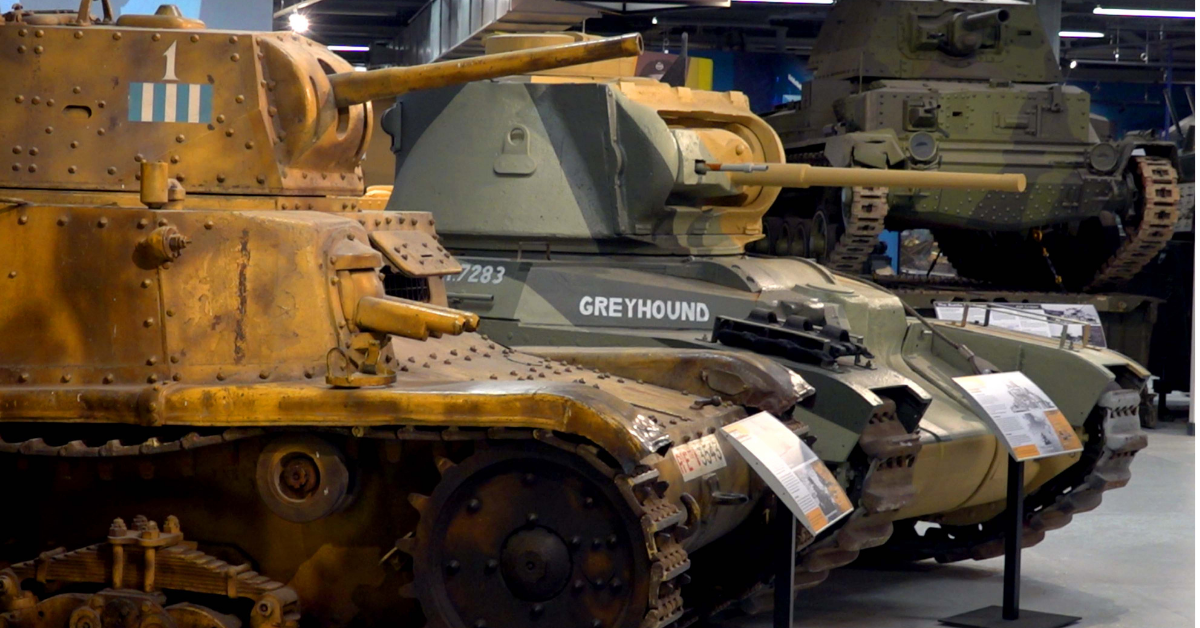The Tank Museum at Bovington in the U.K. is to reopen to the public after the Covid close-down with an extensive and brand new World War 2 exhibition.
Featuring 57 tanks, it covers the whole period of the conflict and takes the visitors on a journey through the key battles and the various tanks that were in them.
What makes this exhibition called “World War 2: War Stories” even more impressive is that they tell the stories of those individuals from the Royal Armoured Corp that were there. Using a series of small items that were such key elements in those various true life accounts.
The exhibition begins with an introduction from veteran Ken Tout, exploring war on the Home Front. This first section features some of the experimental vehicles developed in Britain at the very start of the war. Plus, a recreation of a typical British 1940s house and shop.
The next story is that of Peter Vaux at the Battle of Arras, 1940. A young tank commander who fought against Rommel’s Panzers ended up getting lost in the battle. After running out of petrol, he abandoned his tank in a wood and made off for the British and French lines.
Using his tank’s compass, he escaped through the enemy country. He and his crew lived rough spending 11 days dodging German patrols behind enemy lines. Sadly, his driver Robert Burrows drowned as they crossed the River Somme back to the French lines and safety. Peter was eventually evacuated out of Northern France, just after Dunkirk.
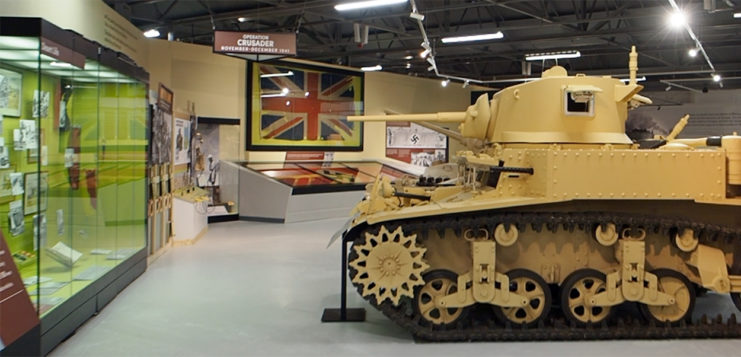
Picture © Geoff Moore/www.thetraveltrunk.net
Stories of the like of Fred Kite — “Bill” Kite of the 3rd Royal Tank Regiment was the only British soldier during the Second World War to be awarded the Military Medal three times. He received his first award for bravery in North Africa in 1943 whilst in charge of three tanks on a reconnaissance mission. The other two awards came from his time fighting in Normandy. His medals are on display in the exhibition with the MM with two bars!
Robert Foote — Victoria Cross recipient. Foote was awarded his Victoria Cross in 1942 while taking part in the Gazala Battles, in the Western Desert. The VC is featured in the exhibition.
Bill Bellamy — His mascot, Audrey, a china doll given to him by his girlfriend before the war, is the only tank mascot on display in the exhibition. It became a cherished good luck charm for his troop. It was at one stage it fell off the tank and the crew went back to get it.
Jake Wardrop — Served throughout the war, from 1940, and died just before the end of the war in April 1945. He serves in France, Germany, North Africa, and Italy. Extracts from his diaries are included throughout the display.
Two large flags make up another part of the exhibition. A Union flag flown during the eight-month siege of Tobruk in World War Two and a huge, German swastika flag captured during the relief operation are on show for the first time together at the Tank Museum.
The siege of Tobruk began on April 10, 1941, when advancing German and Italian troops cut off a skeleton Allied force in the Libyan city in North Africa.
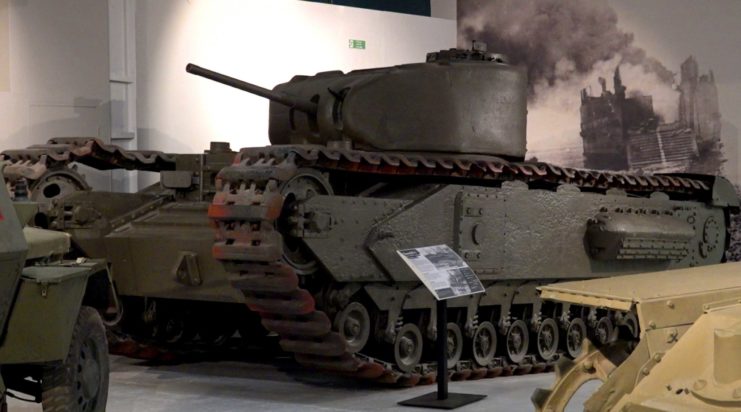
Picture © Geoff Moore/www.thetraveltrunk.net
The main Allied force retreated to the Egyptian border leaving mainly Australian troops of the 9th Division to deny the strategically important port to the Germans.
Although low on supplies and equipment, they defiantly flew the Union Flag over Tobruk despite the German commander Erwin Rommel’s best efforts to take the port and shorten his own stretched supply lines.
Relief operations were launched, the Royal Air Force flew defensive sorties from Egyptian bases and at night the Royal Navy carried in reinforcements and extracted the injured.
Later, new units were rotated into the garrison to replace worn-out and exhausted troops.
But it wasn’t until Operation Crusader, carried out by the 8th Army in November 1941, that the siege was finally ended and the “Rats of Tobruk” were freed.
As part of the plan, the 70th Infantry Division broke out from Tobruk and disrupted German supply lines.
Rommel was surprised by this aggressive attack in his rear and was forced to retreat westwards to Gazala and try to rebuild his forces.
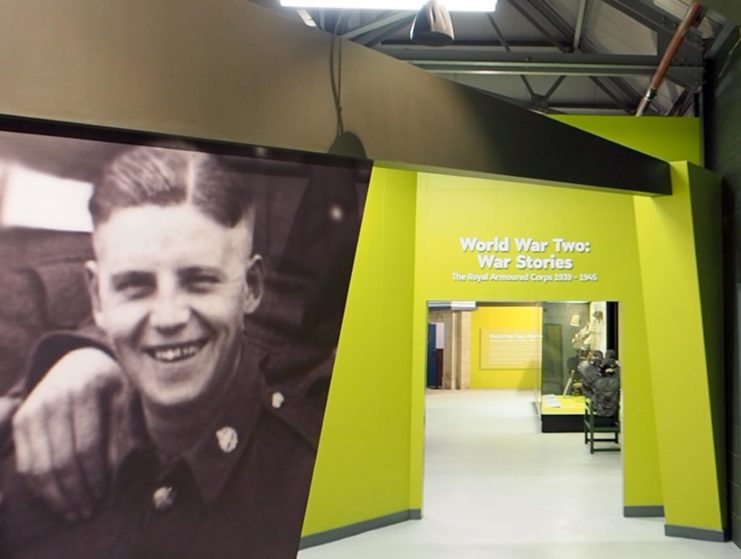
Picture © Geoff Moore/www.thetraveltrunk.net
It was during the relief operations that the swastika flag was captured from an 88mm flak gun locker by the advancing 8th Royal Tank Regiment.
David Willey, curator of the Tank Museum, said: “Flags are so important in conflict as symbols and rallying points – it is of course for many an expression of what you are fighting for, or trying to defend.
“This swastika flag was probably used to help identify the German gun position to their own Luftwaffe pilots.
“Of course, that never happened and the flag instead ended up with the 8th Royal Tank Regiment’s mess.
“Like so many soldiers through history, they wanted to leave their mark – their names recorded for posterity.
“So, Jean Robinson, wife of Capt Robbie Robinson MC of B Squadron 8th Royal Tank Regiment, took on the task of embroidering all their names on the flag.
“How Jean ended up in North Africa is uncertain but she not only embroidered the names of the regiment’s officers but also the places where the battalion had seen action, adding further place names in Italy as the war progressed.
“The flag was displayed at a battalion dinner to celebrate the Allied victory at El-Alamein and even after being donated to the museum it used to be lent back to the regimental association for re-union dinners.
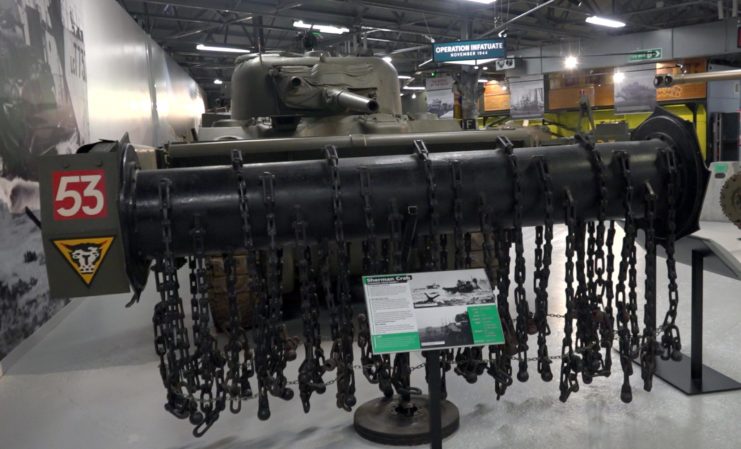
Picture © Geoff Moore/www.thetraveltrunk.net
“We are able to show this captured flag along with the Union Flag that flew above Tobruk during the long siege.
“Countless soldiers must have seen this flag flying; Australian, British, Indian, New Zealand, Polish and Czech soldiers who held out for 242 days despite the efforts of the Afrika Korps to dislodge them.
“The flag was held by the Rats of Tobruk Association until they presented it to the Museum in 1983.
“Both flags are big, powerful objects that really do make a dramatic statement and we are pleased to be able to display them together for the first time in our new World War 2: War Stories exhibition.
“And of course – it goes without saying – the Union Flag is displayed above the Swastika as a symbol of the Victory over Nazism.”
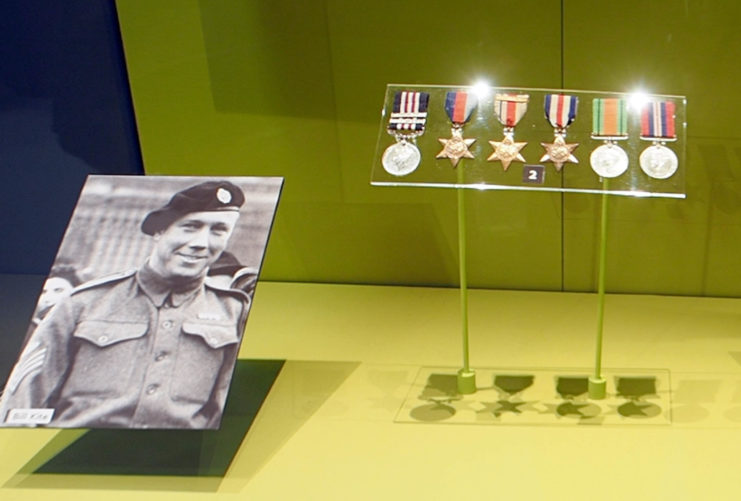
Picture © Geoff Moore/www.thetraveltrunk.net
The areas covering Operation Compass, Operation Crusader, and the Battle for Tunisia, explore the war in North Africa.
A recreation of the disastrous Dieppe Raid includes the world’s oldest surviving Churchill tank. Following this is a look at the Burma Campaign, often unrepresented in armored warfare, with accounts and artifacts from prisoners of war.
As the exhibition moves into the later stages of the war, the D-Day, Battle for Normandy, and the Great Swan sections cover the Allies’ move across France and the Netherlands, liberating their populations before moving into Germany.
Plus, a look at the Gothic Line explores the German defenses in Italy, breached during the Italian campaign.
More from us: D-Day Reenactment Canceled Over Health And Safety Concerns
The brutal fighting in Germany is explored through displays of mighty German armor, like the Jagdpanther.
The exhibition ends with the liberation of the concentration camps and the legacy of the Second World War, including Britain’s first Main Battle Tank – the Centurion.
The 3400 sq. foot exhibition was planned and built over a three-year period.
By Geoff Moore | http://www.traveltrunk.net/
